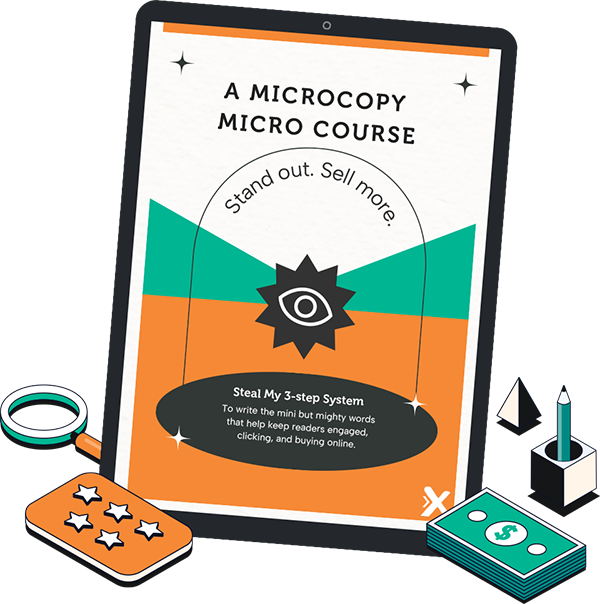Imagine any add, social media post or website without words.
It simply wouldn’t work.
If you’ve been baffled about what is copy in marketing, you’re in the right place.
Choosing the right words is how you’ll meet your marketing goals, whether that’s boosting brand awareness, engaging with your audience, or driving sales.
Copy has the power to persuade, inform, and inspire action, making it an indispensable tool in a successful digital marketing strategy.

The right copy can transform passive readers into active buyers, propelling your business towards a bright, shiny future of thousands of students or customers, not to mention first-class air travel, infinity pools and unlimited massages (#agirlcandream).
But like an iceberg, your copy’s power lies beneath the surface.
So let’s dig in shall we?
The Basics of Copy in Marketing
Let’s start at the beginning: what is copy in marketing?
Simply put, it’s the text that persuades readers to take action – often known as a conversion. This could be anything from buying a product, signing up for a newsletter, to following a social media account.
Copy is the voice of your brand in written form, and it’s everywhere — on websites, ads, emails, and social media posts.
It’s crucial to understand the difference between copy and content, as they serve distinct roles in your marketing strategy.
Copy is about conversion. It’s the persuasive speech that convinces your audience to buy, book a call or download your freebie. It’s direct, action-oriented, and focused on driving specific outcomes.
On the other hand, content is about attracting more eyeballs on your stuff.
This includes blogs, videos, podcasts, most social media posts, newsletters and any other material that provides value to your audience without directly selling something.
Content aims to inform, entertain, or educate, helping to build a relationship with your audience over time.
Both copy and content are essential components of a successful marketing strategy.
While content pulls people in, creating interest and engagement, copy is what nudges them towards taking that final step of action.
Understanding their differences helps in crafting a marketing strategy that not only attracts but also converts.
Types of Copy in Marketing
Copy takes on many forms.
Understanding these variations, from the concise punch of ad copy to the strategic depth of funnel copy, is crucial to successful copywriting.
Let’s explore the different types of marketing copy.
Ad Copy: The Art of Direct Response
What is advertising copy?
Ad copy is the text in advertisements designed to grab attention and provoke immediate action.
It’s the shop floor salesperson of marketing, getting your attention quickly and effectively. The goal is often what is known as “direct response” — you want the reader to do something now, whether it’s clicking a link, making a purchase, or signing up for more information.
Ad copy needs to be concise, memorable, and persuasive.
It’s not just about selling a product or service; it’s about creating a feeling, offering a solution, or presenting a not-to-be-missed opportunity.
A by-product of advertising copy is building brand awareness. AKA making the first impression that could lead to a long-term relationship with your audience.
Launch (Funnel) Copy: Guiding the Customer Journey
If you’ve been wondering what is copy in marketing, you’ve surely heard about “funnels”.
Funnel marketing is a strategy that guides potential customers through a series of steps, from initial awareness of a product or service to making a purchase.
Visualise the customer journey as a funnel, starting broad with many prospects and narrowing down to those who convert into customers.
Launch or funnel copy is the strategic narrative that guides potential customers through the various stages of your marketing funnel.
From initial awareness to the final decision to buy, this copy type is about nurturing leads, building interest, and eventually, compelling action. It’s cross-platform, meaning it might include a combination of ads, emails, webinars, landing pages and sales pages.
Each stage of the funnel has its specific needs — awareness, interest, decision, and action — and the copy must be tailored to meet these needs, moving the reader closer to the ultimate goal of conversion.
Website Copy: Your Online Homebase
Website copy is the backbone of your digital presence.
It’s where you tell your brand’s story, showcase your offerings, and articulate your value proposition. Good website copy performs several functions: it informs, engages, persuades, and converts.
It’s not just about what you say, but how you say it and what order you put it in.
The importance of having compelling, clear, and user-focused website copy cannot be overstated, as it’s often the pivotal point of most marketing efforts.
Discover everything you need to know about writing effective website copy.
Post Copy in Marketing: Engaging on Social Media
What is post copy in marketing?
This refers to the text used in social media posts. It’s a vital part of content marketing, aimed at engaging users, building communities, and driving traffic to websites or landing pages. Social media post copy can vary widely.
The key to effective post copy is understanding the platform and its audience. What works on LinkedIn might not resonate on TikTok.
This type of copy is essential for keeping your brand top of mind, engaging with your audience in real-time, and being part of the broader conversation in your industry.
Email Marketing Copy: Personalising the Conversation
Email marketing copy stands out as a personal and direct line of communication with your audience.
Unlike the broader approach of ad or social media copy, email copy speaks more intimately with the individual.
It’s a powerful tool for building relationships, offering value, and guiding subscribers toward desired actions, such as making a purchase, registering for a webinar, or simply engaging more deeply with your brand.
Want to see how it’s done? Subscribe to the UX Factor Newsletter
Crafting Effective Marketing Copy
Writing compelling copy in marketing is an art that combines psychology, strategy, and creativity.
It’s about understanding how to communicate with your audience in a way that resonates, persuades, and ultimately drives action.
Here’s some hard won tips for mastering the craft of writing copy that not only engages but also converts.
Keep It Basic: Simplicity is Key
The principle of simplicity cannot be overstated.
Your audience is bombarded with information every minute of the day, so your message needs to cut through the noise.
This means translating complex ideas into straightforward, relatable language. The easier it is for your audience to understand what you’re offering and why it matters to them, the more effective your copy will be.
Talk to Your Customers: Know Them Deeply
You can’t write effectively for your audience if you don’t know who they are. This goes beyond demographics.
Dive into their needs, fears, aspirations, and pain points. Engage with them through surveys, social media, and direct conversations to gain insights.
The better you understand your customers, the more precisely you can tailor your copy to speak directly to their situations, making it far more compelling.
Have a UX Strategy: Align with the User’s Journey
Every piece of copy should have a purpose and fit within a broader marketing and UX strategy.
It’s crucial to align your copy with the user’s journey and your business goals.
Whether you’re increasing awareness, driving sales, or nurturing leads, your copy should guide the reader through a seamless journey from initial interest to the desired action.
Understanding where your copy fits in this journey helps ensure it resonates and moves the user closer to conversion.
Learn Your Formulas: Creativity Thrives on Constraints
Copywriting formulas, such as AIDA (Attention, Interest, Desire, Action) and PAS (Problem, Agitate, Solution), are time-tested frameworks that can guide your copy creation.
These formulas help structure your message in a way that captures attention, builds interest, and compels action.
Familiarising yourself with these and other formulas can save you time and make your writing process more efficient and effective.
Emphasise Benefits Over Features
One common mistake in marketing copy is focusing too much on the features of a product or service rather than its benefits.
This is easy to do when you’re so invested and interested in your product or service – you already know the benefit, so it’s easy to assume others will figure it out too.
They won’t.
Remember, people are interested in how your offering can make their life better or solve a specific problem.
Highlighting the benefits connects the dots between what you’re offering and the positive impact it can have on the reader’s life.
Test and Optimise
Finally, continuous testing and optimisation is the key to crafting compelling marketing copy.
What works for one audience may not resonate with another, and consumer preferences can change over time.
A/B testing different headlines, calls to action, and messaging approaches can provide valuable insights into what drives engagement and conversions.
Use this data to refine and improve your copy over time.
Copywriting Resources
Writing compelling copy is an essential skill, not just for copywriters but also for business owners and marketers.
The sheer volume of copy involved in any marketing campaign makes it unlikely you’ll be paying someone every time you need some copy.
Whether you’re crafting an email campaign, updating your website, or posting on social media, the right tools and resources can make all the difference.
Here’s a collection designed to help anyone improve their copywriting skills.
- The UX Web Copywriting Guide: This step-by-step guide is crucial for anyone looking to make their website copy not only readable but user-friendly. It’s a must-read for understanding the intersection of copywriting and user experience.
- Microcopy Micro Course: This is about so much more than crafting effective microcopy. This course will teach you how to support and guide users through their online journey towards working with you with concise and impactful text.
- Beyond Web Copy: This course is designed for copywriters looking to elevate their website copywriting skills in a small group environment. Want to become an in-demand writer who knows how to charge appropriately for high-quality web copy? This is for you (there are only 20 spaces available each year, so get on the waitlist now)
- Site Launcher Lab: Ideal for business owners or marketers planning to craft or overhaul their web copy. Get step-by-step guidance and practical tools to launch your best website yet. (People will think you paid a pro)
Blogs and Resources
- Copywriting Niches Guide: Discover the importance of focusing your copywriting efforts on a specific niche to increase effectiveness and appeal to the right audience.
- Copy Strategy Blog: Gain insights into developing a cohesive copy strategy that aligns with your overall marketing goals and enhances your brand messaging.
- Learn from the Copywriting Geniuses: 33 copywriting quotes that will make you a better writer.
- F-shaped Reading Pattern: Understanding how people read online can dramatically impact how you structure and write your copy. This resource offers valuable tips for optimising readability and engagement.
Planning Tools
- One and Done Web Copy Planner: A comprehensive planner that simplifies organising and implementing your web copy strategy. It’s an invaluable tool for anyone looking to streamline their writing process and ensure their web content is coherent and compelling.
By now, you’re well-equipped to tackle any marketing copy challenge that comes your way.
Whether you’re a seasoned professional or a business owner looking to refine your website, investing time in learning and applying these tools can significantly enhance the quality of your copy.




